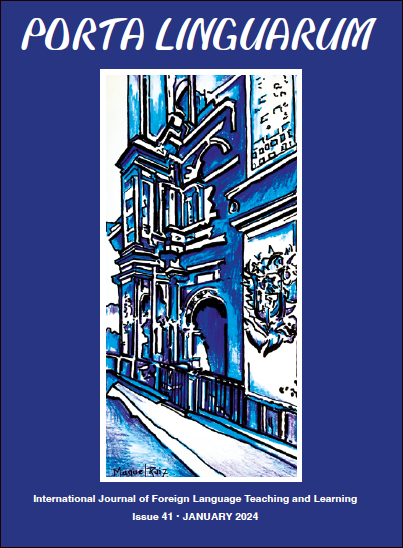Efecto de las estrategias de aprendizaje de lenguas en el desarrollo del vocabulario en AICLE
DOI:
https://doi.org/10.30827/portalin.vi41.27217Palabras clave:
estrategias de aprendizaje de lenguas, AICLE, adquisición de vocabulario, alumnos de Inglés de 1º y 2º de SecundariaResumen
Este estudio investiga el uso de estrategias de aprendizaje de lenguas dentro del contexto del Aprendizaje Integrado de Contenidos y Lenguas Extranjeras (AICLE) para la producción de vocabulario durante un año.
La investigación se realizó en la República Checa en12 clases con una muestra de 286 participantes (11 y 14 años). La mitad del grupo tenía un año de experiencia en AICLE antes del estudio. Las materias de contenido analizadas fueron Historia y Educación Cívica y la lengua de instrucción el inglés. El objetivo del estudio es averiguar cuál es la conexión entre las estrategias de aprendizaje de lenguas y la adquisición de vocabulario en las clases AICLE.
Las pruebas de niveles de vocabulario de Laufer & Nation y el Inventario de estrategias para el aprendizaje de idiomas de Oxford sirvieron como instrumento. Las variables fueron: experiencia en AICLE, género, materia de contenido y docente. El año previo de AICLE y el docente resultaron ser datos significativos. En los cuestionarios, cinco estrategias mostraron una influencia positiva en el incremento del vocabulario productivo. Sorprendentemente, otras cinco estrategias impactaron negativamente en la producción de vocabulario. Las estrategias basadas en tareas demostraron ser superiores a las estrategias basadas en la adquisición de vocabulario.
Descargas
Citas
Adan, D. A., & Hashim, H. (2021). Language learning strategies used by art school ESL learners. Creative Education, 12, 653-665. https://doi.org/10.4236/ce.2021.123045
Coyle, D. (2011). ITALIC research report – investigating students gains: Content and language integrated learning. Aberdeen: University of Aberdeen.
Dale, L., van der Es, W., & Tanner, R. (2011). CLIL skills. Leiden: Expertisecentrum mvt.
Dalton-Puffer, C., & Smit U. (2013). Thinking allowed. Content and language integrated learning: A research agenda. Language Teaching, 46.4, 545-559. doi:10.1017/S0261444813000256
Deller, S., & Price, Ch. (2007). Teaching other subjects through English. Oxford: Oxford University Press.
De Zarobe, Y. R. (2010). First languages and age in CLIL and non-CLIL contexts. International CLIL Research Journal, 3(1), 61–66.
Ellis, R. (2003). Task-based language learning and teaching. Oxford: Oxford University Press.
Habók, A., & Magyar, A. (2018). The effect of language learning strategies on proficiency, attitudes and school achievement. Frontiers in Psychology 8, 1-8. doi: 10.3389/fpsyg.2017.02358
Jaikrishnan, S., & Ismail, H. H. (2021). A review on vocabulary learning strategies used in learning English as a second language. International Journal of Academic Research in Business and Social Sciences, 11(9), 297–309.
Lasagabaster, D., & Sierra, J. M. (2009). Language attitudes in CLIL and traditional EFL classes. International CLIL Research Journal, 2(1), 5-18.
Marsh, D. (2013). The CLIL trajectory: Educational innovation for the 21st century iGeneration. Córdoba: Servicio de publicaciones de la Universidad de Córdoba.
Mehisto, P., Marsh, D., & Frigols, M.J. (2008). Uncovering CLIL. Content and language integrated learning in bilingual and multilingual education. Oxford: Macmillan.
Mehrabian, N., & Salehi, H. (2019). The effects of using diverse vocabulary learning strategies on word mastery: a review paper. Journal of Applied Studies in Language, 3(1), 100-114.
Min, T. S., Wei, C. X., Rohaizat, N., Mohamed, K., Nie, A. F., & Hashim, H. (2021). Language learning strategies in acquiring English language skills among year 5 pupils in rural areas in southern Malaysia. International Journal of Academic Research in Business and Social Sciences, 11(7), 1247–1256.
Norris, J., & Ortega, L. (2000). Effectiveness of L2 instruction: A research synthesis and quantitative meta-analysis. Language Learning, 50, 417-528.
Oxford, R. L. (1990). Language learning strategies: What every teacher should know, Boston, USA: Heinle & Heinle Publishers.
Oxford, R. L. (2003). Language learning styles and strategies: Concepts and relationships. IRAL, 41, 271-278. https://doi.org/10.1515/iral.2003.012
Seikulla-Leino, J. (2007). CLIL learning: Achievement levels and affective factors. Language and Education, 21(4), 328–341.
Van de Craen, P. (2007). An interdisciplinary research approach to CLIL learning in primary schools in Brussels. In C. Dalton-Puffer, & U. Smit (Eds.), Empirical perspectives on CLIL classroom discourse (pp. 253–274). Frankfurt: Peter Lang.
Van den Branden, K. (Ed.). (2006). Task-based language education: From theory to practice. Cambridge: Cambridge University Press.
Van den Branden, K., Bygate, M., & Norris, J. (Eds.) (2009). Task-based language teaching: A reader. Amsterdam: John Benjamins.
Vimalakshan, S., & Aziz, A. A. (2021). Investigating language learning strategies used by ESL lower secondary learners from national and vernacular school background. International Journal of New Technology and Research, 7(1), 41-47. https://doi.org/10.31871/IJNTR.7.1.13
Vollmer, H. J. (2006). Subject-specific competence and language use of CLIL learners: The case of geography in grade 10 of secondary schools in Germany. In C. Dalton-Puffer (Ed.), CLIL: From practice to principles. Annual Review of Applied Linguistics, 31(1), 182–204.



















